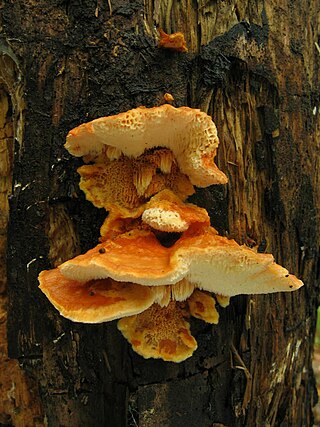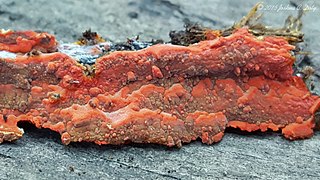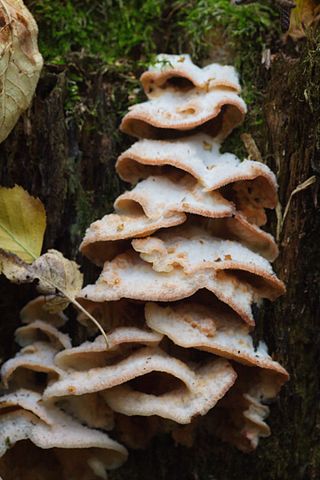
The Meruliaceae are a family of fungi in the order Polyporales. According to a 2008 estimate, the family contains 47 genera and 420 species. As of April 2018, Index Fungorum accepts 645 species in the family.

Phlebia is a genus of mostly crust fungi in the family Meruliaceae. The genus has a widespread distribution. Phlebia species cause white rot.

Mycoaciella is a genus of corticioid fungi in the family Meruliaceae. The genus was circumscribed by John Eriksson and Leif Ryvarden in 1978. After microscopic examination of the three species then in the genus, Karen Nakasone proposed to synonymize Mycoaciella with Phlebia.
Cabalodontia is a genus of fungi in the family Steccherinaceae. The genus was circumscribed by Marcen Piątek in 2004 for five species formerly placed in Phlebia. It is named in honour of Polish phycologist Jolanta Cabała. The type species, C. queletii, has an odontoid hymenophore featuring toothlike projections.

Coenurosis, also known as caenurosis, coenuriasis, gid or sturdy, is a parasitic infection that develops in the intermediate hosts of some tapeworm species. It is caused by the coenurus, the larval stage of these tapeworms. The disease occurs mainly in sheep and other ungulates, but it can also occur in humans by accidental ingestion of tapeworm eggs.
Taenia serialis, also known as a canid tapeworm, is found within canines such as foxes and dogs. Adult T. serialis are parasites of carnivores, particularly dogs, with herbivorous lagomorph mammals such as rabbits and hares, serving as intermediate hosts. In definitive hosts, T. serialis is acquired by eating tissues from a variety of intermediate hosts. Accidental infection of humans though, can occur when eggs are ingested from food or water contaminated with dog feces and the human then becomes the T. serialis intermediate host.
Arta serialis is a species of snout moth in the genus Arta. It was described by George Hampson in 1897 and is known from Brazil.

George Francis Atkinson was an American botanist and mycologist.

Neoantrodia serialiformis is a species of polypore fungus in the family Fomitopsidaceae. The fungus is resupinate, consisting of a fertile spore-bearing pore surface lying flat on the underside of decaying wood, although one or more fan-shaped overlapping caps may also be formed. Although quite common in the eastern United States, it was not recognized as a distinct species until 2009, owing to its resemblance to the closely related Neoantrodia serialis. Differences in ecology, spore size, and DNA sequences distinguish the two lookalikes.

Neoantrodia serialis is a species of polypore fungus in the family Fomitopsidaceae. Originally named Polyporus serialis by Elias Fries in 1821, it was ttransferred to its current genus by Canadian mycologist Serge Audet in 2017. A widespread species, N. serialis causes heart rot in living trees. In North America, it is often confused with the morphologically similar Neoantrodia serialiformis, which grows on oak.

Phlebia incarnata is a species of polypore fungus in the family Meruliaceae. It is inedible.
Dicranucha serialis is a moth of the family Gelechiidae. It was described by Edward Meyrick in 1908. It is found in the Democratic Republic of the Congo, Mozambique and Gauteng, South Africa.

Phlebia radiata, commonly known as the wrinkled crust, is a common species of crust fungus in the family Meruliaceae. It is widespread in the Northern Hemisphere. It grows as a wrinkled, orange to pinkish waxy crust on the decaying wood of coniferous and deciduous trees, in which it causes a white rot. The fungus was first described scientifically in 1821 by Elias Magnus Fries.

In Finland, Kotiranta and Niemelä introduced a widely used method for comparing the conservation values of different forest areas, based on the observation that certain wood-rotting fungi are very sensitive to the impact of human activities on forest ecosystems. Such species are slow to return to areas from where they have disappeared, so their presence is evidence of a long continuity in forest ecosystems.

Phlebia centrifuga is a species of crust fungus in the family Meruliaceae. It was described in 1881 by Petter Karsten.
Phlebia crassisubiculata is a species of crust fungus that is found in India. It was described as new to science in 2010. The type specimen was found growing on the underside of a decaying stump of gymnospermous wood in the Dalhousie hills of Himachal Pradesh. The specific epithet crassisubiculata refers to the "conspicuously thick subiculum" that is characteristic of the species.

Phlebia coccineofulva, commonly known as the scarlet waxcrust, is a species of crust fungus in the family Meruliaceae. It was described as a new species by Lewis David de Schweinitz in 1832. The fungus is found in North America, continental Europe, and northern Asia, where it grows as a saprophyte on decaying stumps and woody forest debris.

Phloiophilus edwardsii is the sole known species of the beetle family Phloiophilidae in the superfamily Cleroidea. It is native to Europe. The larvae are mycophagous, and have been observed feeding on basidiomycetes of the genus Phlebia growing on dead oak branches. The larvae are active during the winter period, before entering the soil to pupate in late spring-early summer.

Phlebia tremellosa, commonly known as trembling Merulius or jelly rot, is a species of fungus in the family Meruliaceae. It is a common and widely distributed wood-decay fungus that grows on the rotting wood of both hardwood and conifer plants.
Oldfeltia is a genus of flowering plants belonging to the family Asteraceae. It contains only one known species, Oldfeltia polyphlebia.














